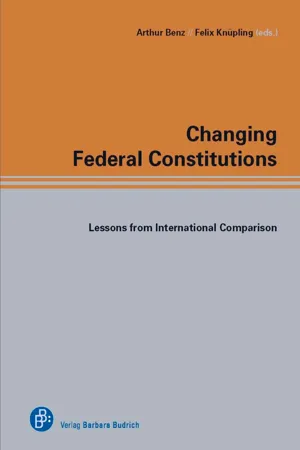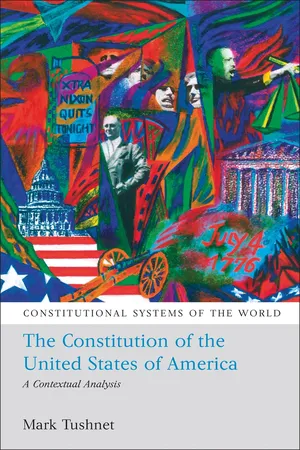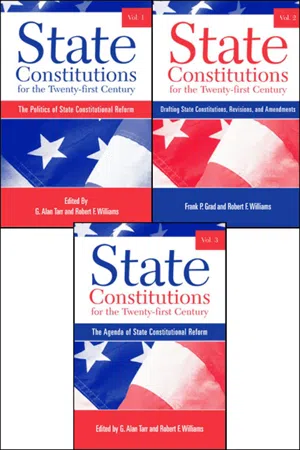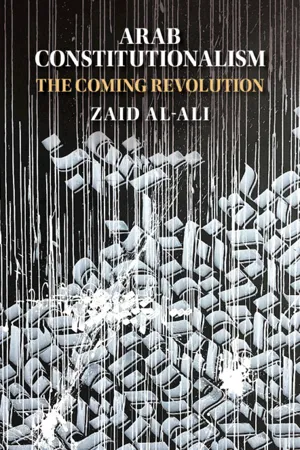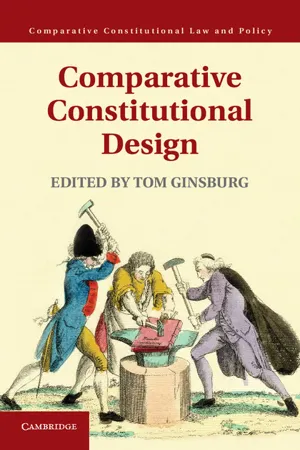Politics & International Relations
Constitutional Amendment Process
The constitutional amendment process refers to the formal procedure for making changes to a country's constitution. This typically involves a series of steps, such as proposal, ratification, and enactment, which are outlined in the existing constitution. The process is often designed to be deliberate and difficult in order to ensure that amendments reflect broad consensus and are not made hastily.
Written by Perlego with AI-assistance
Related key terms
1 of 5
5 Key excerpts on "Constitutional Amendment Process"
- Available until 15 Jan |Learn more
Changing Federal Constitutions
Lessons from International Comparison
- Arthur Benz, Felix Knüpling, Arthur Benz, Felix Knüpling(Authors)
- 2012(Publication Date)
- Verlag Barbara Budrich(Publisher)
5. Processes of Ratification Constitutional Amendment Rules in Federal and Unitary States Markus Kaltenborn 1. Introduction There can be different reasons for amending the rules or sets of rules con-tained in a constitution. Besides the particular problems inherent in each legal system, developments at the international or supranational level often induce the constitutional reform process, for example, most notably, with respect to European constitutional law and the compliance with EU or EC laws. Additionally, the accelerated globalisation of economic relationships ex-erts pressure on national constitutional law. Increasingly, states – and their legal systems – are competing for investments, tax revenue and jobs. The constitution as a cornerstone of each legal system and its ability to adapt and to efficiently fulfil state responsibilities is seen as a factor in this competition. Whether it aims at overcoming budgetary problems, the efforts of “young” democracies to strengthen the rule of law in their countries, the fight against unemployment, or the expansion or restructuring of the social security system – each of these political reform projects requires effective decision-making processes. Frequently, constitutional amendments (or even major constitu-tional reforms) are seen as necessary in order to support policy reforms or to make them possible at all. Recent examples of this include the reforms of German federalism (Häde 2006, 2010; Ipsen, 2006; Meyer, 2008) and the second constitutional reform in Italy – defeated in a referendum in 2006 though (Panizza, 2006). According to the driving political powers behind these reforms, constitutional amendments are supposed to render decision-making more efficient by reorganising the current allocation of powers be-tween a central government and its constituent units, or between individual constitutional bodies. - eBook - ePub
The Constitution of the United States of America
A Contextual Analysis
- Mark Tushnet(Author)
- 2008(Publication Date)
- Hart Publishing(Publisher)
7 The Processes of Constitutional Change Someone who attempted to understand constitutional change in the United States by reading the written Constitution’s provision on amending the Constitution would be misled. The formal amendment process is only one, and almost certainly the least important, of several mechanisms of constitutional change. Constitutional interpretation accounts for a much larger portion of constitutional change. Yet, though interpretation may be the statistically dominant form of constitutional change, it is not the structurally dominant form. That form is the ‘regime shift’, described, as we will see, somewhat misleadingly by law professor Bruce Ackerman as involving occasional constitutional ‘moments’ after which the array of institutions in the government as a whole is dramatically different from what it had been earlier. And, in general, shifts in constitutional interpretation as a mechanism of constitutional change occur as a result of changes in the courts attendant upon regime shifts. FORMAL AMENDMENTS Processes Article V of the Constitution sets out the formal amendment process. If supported by two-thirds of both houses of Congress, an amendment will be submitted to the states for ratification. A proposed amendment becomes part of the Constitution if it is ratified by three-quarters of the states. 1 There is no time limit set in the Constitution for ratification. Several amendments, by their own terms, specified that they had to be ratified within seven years, as they were. 2 The proposed Equal Rights Amendment dealing with gender equality was submitted to the states pursuant to congressional resolutions that set a similar time limit, but not embedded within the proposed amendment. The amendment secured ratifications from 35 states, three short of the needed three-quarters, when the seven years expired. Anticipating that outcome, Congress enacted an extension of the time period, the legality of which was challenged but not adjudicated - G. Alan Tarr, Frank P. Grad, Robert F. Williams, G. Alan Tarr, Frank P. Grad, Robert F. Williams, Robert F. Williams(Authors)
- 2007(Publication Date)
- SUNY Press(Publisher)
17 What is true for amendment is also true for revision. The process provided in the U.S. Constitution for revision has never been used. In contrast, state constitu- tional revision has been relatively frequent. There have been more than 230 con- stitutional conventions in the United States, and 146 state constitutions adopted. 6. Constitutional Location of Change Processes: Modern drafters usually include provisions for legislatively initiated constitutional amendment or revision, or for the calling of constitutional conventions, in a separate article in the docu- ment devoted to constitutional change. 18 Some constitutions, however, place pro- visions for amendment in the legislative article, or in a general or omnibus article. Provisions for popularly initiated amendment or revision are variously including in the article on the amending process, the legislative article, or in separate arti- cles providing for initiative and referendum. 19 To reduce complexity and assure full understanding of available options, there is virtue in a single constitutional lo- cation for all means for formal constitutional change available to the polity. 7. Democratic Theory Requires Popular Ratification: The first Ameri- can state constitutions explicitly or indirectly emphasized popular authority. 20 Relatively early in the nation’s history state constitutions came to created 180 CONSTITUTIONAL AMENDMENT AND REVISION through special processes—conventions elected for the explicit, singular pur- pose of drafting and proposing them—with the results of their work subject to public ratification. 21 This gave the final word on the structure of governance to the sovereign people. At the beginning of the twenty-first century the adoption of a formal constitutional change in all states but Delaware required a popular vote.- eBook - PDF
Arab Constitutionalism
The Coming Revolution
- Zaid Al-Ali(Author)
- 2021(Publication Date)
- Cambridge University Press(Publisher)
In many countries in the region and beyond, legislation is often only adopted after serious consideration is given to its possible impact on state and society. Increasingly, the legislative process includes studying the budgetary impact of bills before they are adopted; open consultations with broad segments of the population who are given sufficient time and opportunity to prepare and deliver their interventions; the publication of drafts; the solicitation of input from subject matter experts; and modeling the impact of specific provisions before they are finally adopted. Automated procedures are increasingly common and allow for greater numbers of individuals to provide input, track their input systematically, and compare versions while reducing human error or bias. 25 None of these methods were adopted in the post-2011 constitutional 25 See, for example, Wim Voermans, Hans-Martien ten Napel, and Reifer Passchier, “Combining Efficiency and Transparency in Legislative Processes,” The Theory and Practice of Legislation, Vol. 3 (2015), 279–294. 286 Process Design (or on Avoiding Majoritarianism) processes. Obviously, constitutional processes are far more political than most ordinary laws and the stakes much higher, which inevitably means that they are more difficult to manage. But in most post-2011 processes, the negotiations and drafting appeared to be driven by what can be described as a faith-based approach that is practically untouched by modernity. Throughout many of the processes, inconvenient facts were simply ignored in the hope that the parties would reach agreement through force of will, failing which a majoritarian constitution would be imposed in the hope that the opposition could be brought under control. Impact: In Yemen, the National Dialogue Conference decided that the country should be reconstituted as a federation but did not come close to discussing how that federation would function. - eBook - PDF
- Tom Ginsburg(Author)
- 2012(Publication Date)
- Cambridge University Press(Publisher)
Does the Process of Constitution-Making Matter? 37 The modal form of participation in constitutional design is the power to approve the charter, usually by referendum on the final document as a whole. Figures 3.1 and 3.2 present historical data on the processes of promulgating constitutions, and on public promulgation in particular. Figure 3.1 plots the percent of constitutions in force, by year, whose text requires public ratification. The plot suggests a signif- icant trend, accelerating in the early twentieth century, toward public ratification. We emphasize that the denominator here includes only those constitutions that specify the promulgation procedure in the text itself. As Figure 3.2 attests, although a majority of modern constitutional texts provide information on promulgation, most nineteenth-century texts were silent on the topic. We thus treat the findings in Figure 3.1 with some caution, although it seems unlikely to us that the shift in norms regarding the appearance of promulgation procedures in the text biases the results significantly. Indeed, our review of extratextual case information for a smaller sample suggests that the trend implied by the cases plotted in Figure 3.1 is fairly rep- resentative of the trend within the full universe of cases. Thus, it seems likely that public ratification has been on the rise since the turn of the twentieth century. Approval by referendum may be an increasingly popular mode of public involve- ment, but it is clearly a limited one in that it involves only an up-or-down vote over Table 3.1.
Index pages curate the most relevant extracts from our library of academic textbooks. They’ve been created using an in-house natural language model (NLM), each adding context and meaning to key research topics.
